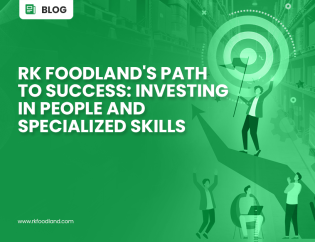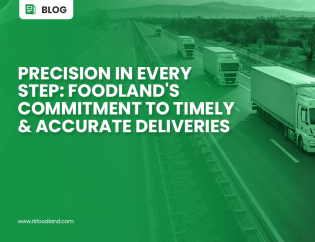
[Avg. Read Time < 4 mins]
In today’s fiercely competitive food industry, businesses need to have a deep understanding of their strengths and weaknesses, as well as a thorough analysis of the demand landscape to stay ahead of the competition. Managing highly perishable goods, adapting to seasonal changes, complying with stringent regulations, and navigating an unpredictable, dynamic, and constantly evolving market, presents a significant challenge for businesses in the food industry. To succeed in this BANI environment, it is essential to understand and forecast the exact needs of customers, which requires a significant amount of effort and expertise. This is where Demand Planning proves advantageous, enabling businesses to shift from a reactive, uncertain approach to a proactive approach leading to satisfied customers and a healthy bottom line. Demand planning lowers estimation errors by 15% and inventory levels by 20%, resulting in better outcomes and accelerated business value. This way, demand planning gives food businesses a competitive edge and helps them thrive in a challenging and constantly shifting market.
This blog examines how demand planning capabilities enhance business performance and growth across three levels: Supplier management, Inventory management, and Consumer demand management.
Improve Supplier Performance with better Control and Visibility
Imagine receiving a wrong shipment of SKUs or running out of a key ingredient during the peak production season. Effective supplier management is crucial to the success of any food business, and demand planning plays a significant role in achieving it. Without proper Material Requirement Planning (MRP) from businesses, suppliers may struggle with overproduction, stock-outs, and delivery delays, all of which negatively impact their production schedule and further the overall SCM efficiency. With effective demand planning, businesses are well-positioned to mitigate supply risks and enhance supplier management. Businesses can work closely with suppliers to optimize resource allocation and production planning. This leads to better flexibility and an increased ability to react to market demands in real-time. Moreover, demand planning allows businesses to identify potential issues early and address them proactively. This leads to improved forecast accuracy, better SIFOT rates, and reduced inventory levels. All of which contribute to better supplier performance and management.
Regulate Cash Flow and Reduce Waste with effective Inventory Planning
When it comes to inventory management in the food industry, space is a valuable commodity. Inefficient inventory management leads to a host of challenges, such as overcrowding, disorganization, excessive inventory, and delayed shipments. These issues cause problems not only within the inventory management system but also throughout the entire supply chain. Fortunately, demand planning capabilities enable businesses to mitigate these challenges by improving inventory management and reducing inventory days. By accurately forecasting demand, businesses can optimize their inventory levels, and ensure that the right products are in stock at the right time. This also helps in better managing batches and SKUs, streamlining operations and improving resource allocation. With better inventory management comes increased flexibility, allowing businesses to pivot quickly and respond to changing market conditions. Additionally, by reducing excess inventory, businesses can minimize waste and reduce likelihood of expired products, further improving efficiency and profitability.
Leverage Consumption Insights to Drive Profitability and Business Growth
In hyper-competitive and demand-driven market landscape, it is not enough to simply react to market trends – food businesses must anticipate and proactively respond to consumer demands. This ability to anticipate consumer trends is crucial for the success of any food business. Insufficient demand planning at customer side results into product stock-outs leading to loss of sale, whereas an excess might result in wastage from unsold inventory. This negatively impacts the customer experience and leads to negative word-of-mouth reducing customer loyalty. However, food businesses with demand planning capabilities effectively handle demand fluctuations and delivering product quality and reliability. The actionable insights derived from demand planning data helps businesses better understand their customers’ needs and preferences, leading to increased customer satisfaction and re-purchases. By utilizing accurate forecasting, food businesses strategically position their products at the most opportune times and locations, leading to better availability and visibility. This helps businesses main a competitive edge with increased profitability and driving growth.
To conclude, demand planning is a vital process for any food business looking to succeed in a competitive market. The ability to anticipate demand and plan accordingly has a significant impact on all aspects of supply chain, from supplier management to inventory management and distribution to consumption trends.
By implementing demand planning capabilities, food businesses can:
- effectively manage partnerships across the eco-system,
- proactively develop contingency plans to mitigate risks,
- plan promotional activities to boost sales and reduce excess inventory,
- utilize insights to develop new products.
Demand planning is a strategic process that delivers beyond operational planning. It is a critical tool for both short-term and long-term sustainable growth helping businesses take informed decisions related to production planning, inventory management, and identify opportunities for innovation & market expansion. In today’s dynamic and ever-changing market, demand planning is not a luxury but a necessity, and businesses that embrace it are positioned for long-term success.
Looking to optimize your food business with demand planning? Connect with our team of experts at RK Foodland now and discover how we can assist you in predicting and planning your path to success.
Related Content | Foodland’s Resources
Link 1 – Demand Management: A Critical Success Factor In The Food And Beverages Industry
Link 2 – Demand-Driven Planning: Lessons From The Supply Chain
Link 3 – Best Practices in Demand and Inventory Planning









